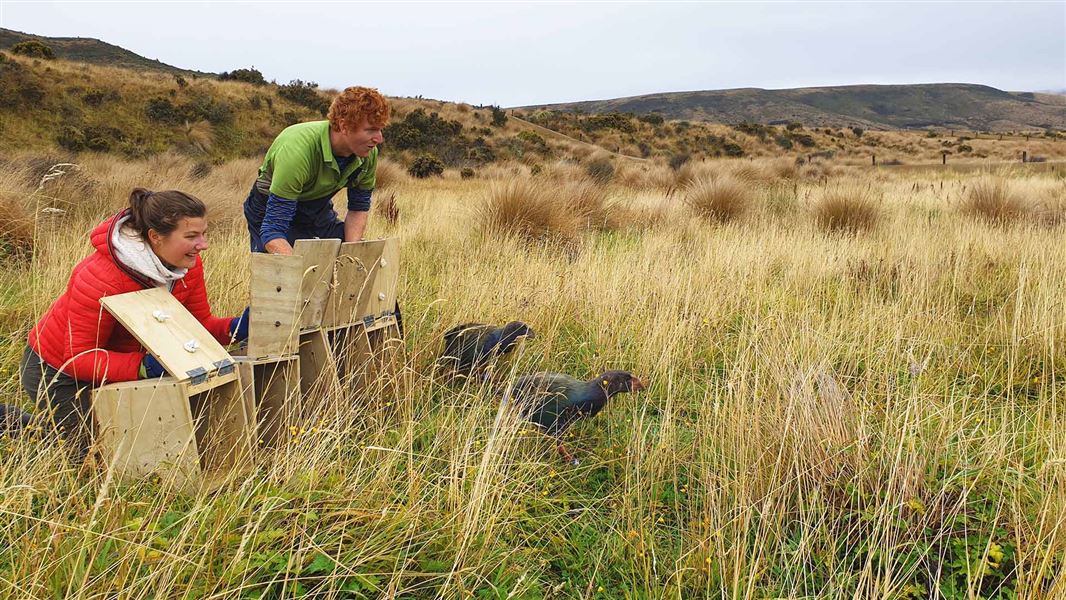As of 2023, there are about 500 takahē in New Zealand.
About 55% of these takahē are living in the wild, up from 32% in 2017. The rest live in small groups across 18 island and mainland sanctuaries around the country.
The graph below shows the takahē population growth across recovery sites and sanctuary sites.
Graph data updated: October 2023. Population year runs August to September.
Why we transfer takahē
We plan the movements of takahē each year, generally before and after the breeding season.
The Takahē Recovery Programme is in the business of making more takahē. Every transfer is planned and carried out with this aim in mind. The health, age and reproductive success of each takahē is continually reviewed and used in transfer plans.
Genetics
Because of the small size of our sanctuaries, they are at risk of inbreeding. We treat all 18 sites as one population (metapopulation) and encourage genetic mixing by transferring birds between the sites.
We want to make sure there is genetic diversity so that every breeding pair can produce healthy chicks. We know the genetic backgrounds of all birds, except for some wild ones. Takahē rangers make sure that birds from the same family aren't paired together to prevent inbreeding.
Single and looking for lifetime partner
Takahē reach breeding age at around 3 years old but will pair up from 2 years old. Their chosen mate will often be with them for life. We ensure all single birds have the opportunity to find an appropriate mate.
Divorced or widowed
Takahē who have lost mates will pair again. Sometimes birds will also trade in their mate for another, leaving their previous mate in need of a new partner. We play Cupid and ensure these gaps are filled.
Infertile or elderly takahē
As they get older, takahē become less fertile. When this happens, we move the older takahē to retirement sites so we can make sure the best habitats for breeding are available to younger couples. The older takahē often spend their time at public sites, such as Kapiti Island. It’s a great opportunity for people to see these colourful ambassadors.
Territorial takahē and disruptive singles
Takahē are territorial and will aggressively defend their breeding habitat from other takahē. This can result in death or injury. Takahē territories can vary in size from 1 to 100 hectares, depending on the quality of the habitat. A single (unmated) bird may disrupt breeding. In these cases, we move the bird to another site.
Two is company, three is a crowd
Sometimes if there are more males than females, takahē will form trios and two females incubate eggs. Whenever two males end up in a breeding group, we try to split them up to ensure better productivity.
This island ain't big enough for all of us
Sometimes the islands and sanctuaries aren’t big enough for all the takahē. As the population grows, there might not be enough space for them all. We may need to move young takahē to another location or they might be returned to the wild.
Some of the sanctuaries are experiencing regrowth of native bush. Although this is good, it can mean the habitat takahē need is shrinking and sites can’t fit as many breeding pairs.
A change is as good as a holiday
Sometimes takahē just need a new mate, location or some rest and recovery from injury. In these situations, we'll move the takahē to the Burwood Takahē Centre, near Te Anau. Our experienced rangers will give them extra care and attention. When their condition improves, we'll transfer them to a new home.
Home under invasion
We’ll relocate takahē from areas with threats that we can’t quickly manage, such as a serious predator invasion.
![]()
Ranger radio monitoring takahē
Image: DOC

Releasing takahē into their new home
Image: DOC
